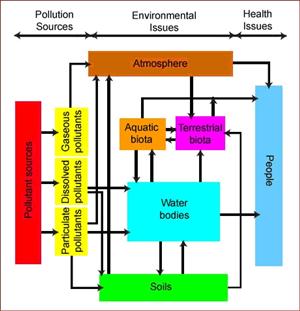Water Quality Indicators: Industrial Chemicals
Industrial chemicals include thousands of carbon-based, often synthetically-produced chemicals used in agriculture and in manufacturing, pharmaceutical, chemical, and other industries. Their properties and toxicity vary depending on their chemical structure. Some industrial chemicals that present a threat to aquatic ecosystems are described below.
PCBs
Polychlorinated biphenyls (PCBs) are a group of chemically stable compounds that were produced for a variety of industrial and commercial applications until production was banned in 1977. Although they are no longer made, they can still be found in plasticizers, and in electrical wire insulation produced before the ban.
The high stability of these compounds means that PCBs resist biological, chemical, and thermal degradation in the environment. Instead, PCBs tend to accumulate in sediments, and bioaccumulate in the food chain.
PCBs cause a variety of serious health effects on the immune, reproductive, nervous, and endocrine systems. Their toxicity varies depending on the chlorine content in each molecule. Sources of PCBs include industrial and municipal effluent discharges. Also, because PCBs are used around the globe, an environment can become contaminated by deposition from the atmosphere, even if no PCBs are discharged locally.
Dioxins and Furans
Dioxins and furans are toxic organochlorine compounds that are found in very small amounts in the environment, including air, water, and soil. Sources of dioxins and furans in Canada include the large-scale burning of waste, the production of iron and steel, and the combustion of fuels and wood (Health Canada 2006). Pulpmills have historically been a significant source of dioxins and furans in aquatic ecosystems, but changes to industrial processes (i.e., elimination of elemental chlorine bleaching) have reduced or eliminated the discharge of these chemicals. Natural sources of dioxins include forest fires and volcanic eruptions.
The most toxic form of dioxin or furan is 2,3,7,8-tetrachlorodibenzo-p-dioxin (or 2,3,7,8-TCDD). In fact, the toxicity of all other related dioxin and furan compounds (or congeners) are rated from 0 to 1 relative to 2,3,7,8-TCDD (rated as 1).
Dioxins and furans are of special concern due to their ability to accumulate in body fat and move up through the food chain into top predators (e.g., humans). Dioxins and furans can accumulate in fish, prompting consumption guidelines to protect human health. Within the Athabasca River basin, levels of dioxins and furans have declined substantially relative to the late 1980s (NRBS 2002).









